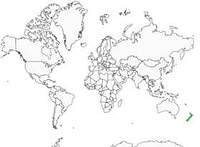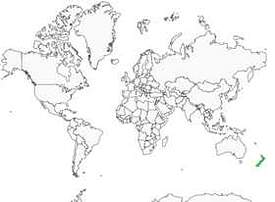North Island Brown Kiwi
Apteryx mantelli - Kiwi de Mantell
Identification
It is an endemic species of the North Island of New Zealand. North Island Brown Kiwi, feathers appear pointed, dark brown streaked with reddish-brown and black, it has a long pale beak, short dark tarsi, black fingers are provided with large dark claws. Nocturnal in habits, unable to fly, like other species of kiwi it is apterous, with small vestigial wings and no tail. The pectoral muscles are not developed. They have no sternum, which makes them particularly vulnerable to crush injuries from dog bites. Females are on average 20-30% larger than males.
Subspecific information monotypic species
Foreign names
- Kiwi de Mantell,
- Kiwi norteño,
- kiwi-do-norte,
- Nordstreifenkiwi,
- északi-szigeti barna kivi,
- Noordelijke Bruine Kiwi,
- Kiwi bruno settentrionale,
- brunkivi,
- Nordbrunkivi,
- kivi hnedý,
- kivi hnědý,
- Nordø Dværgkiwi,
- pohjoissaarenruskokiivi,
- kiwi bru de l'illa Nord,
- kiwi północny,
- Северный киви,
- キタキーウィ,
- 北岛褐几维,
- 北島褐鷸鴕,
Voice song and call
Habitat
Widely distributed and locally common in native forests, scrub and agricultural areas from sea level up to 1,400 m., the North Island Brown Kiwi is found.
Behaviour character trait
During the day, North Island Brown Kiwis rest in a burrow, a hollow tree, or under thick vegetation and emerge shortly after dusk. Like their cousins from other species, they feed by walking slowly, tapping the ground. When prey is detected, they probe the litter of leaves or rotten wood with their beaks; they can sometimes plunge their beaks deeply into the ground. They call out to each other from time to time, every night, to mark their territory and remain in contact with each other as a couple. The couples often sing duets, responding to each other a few seconds after the first call. It is a territorial bird that fights off intruders entering its territory with sharp claws and talons. It will stay on this territory as long as its habitat remains favorable.
Flight
Flightless bird.
Dietfeeding habits
They mainly feed on small invertebrates, especially earthworms, beetle larvae, cicadas and mites; they also eat millipedes, spiders, Weta grasshoppers, and some small fallen fruits, and leaves are also consumed.
Reproduction nesting
Mating pairs form for life. For the species, the peak breeding generally takes place in June-July. The nest is established in a shallow burrow, rock crevice, hollow tree stump or hollow tree trunk. The clutch size is 1-2 white eggs of very large size. The male incubates the eggs alone. He may lose up to 20% of his weight during this period. They are left without surveillance during the night, but the male's presence outside the nest decreases with time and the incubation period lengthens. It lasts from 75 to 90 days. The young leave the nest between 5 and 7 days; they return daily for 2 to 10 weeks, then become independent. The dispersal of immature North Island Brown Kiwis may reach 22 km. They are able to reproduce at the age of 4.
Geographic range
The North Island Brown Kiwi is the only species of kiwi living in the wild in the North Island. The bulk of the population is found in larger and smaller islands in the Northland, in several islands of the Hauraki Gulf, on the Coromandel Peninsula, in the Bay of Plenty, in the north and west of Hawkes Bay, Tongariro, Taranaki, and Whanganui. There are also recently established populations at Tawharanui (North Auckland), Maungatautari (Waikato), Cape Kidnappers (Hawke's Bay), Pukaha/Mt Bruce (Wairarapa), and the Rimutaka Range (Wellington). During European colonization, the distribution was much wider, particularly in North Auckland and the Waikato.
Threats - protection
IUCN conservation status
concern
in the Wild
threatened
evaluated
The North Island Brown Kiwi has disappeared from many lowland sites and at the edges of its distribution, due to a combination of habitat loss and predation from introduced mammals, particularly dogs, ferrets, and stoats. Management of predators at the landscape level by periodic aerial broadcasting of 1080 poison-laced bait, trapping, has slowed and reversed the population decline on many territories. Egg harvesting or taking chicks from the wild for captive rearing and predator-proof crèches until they have grown large enough (1.2 kg) to stand a chance against the presence of stoats, has enabled these populations to increase. It has been reintroduced in areas where populations had decreased or become locally extinct. UNIC classification: Endangered.
Sources of information
- IOC World Bird List (v15.1), Gill, F and D Donsker (Eds). 2025-12-07.
- xeno-canto, Sharing bird sounds from around the world,
- Vol. 1 - Handbook of the Birds of the World, Josep del Hoyo-Andrew Elliot-Jordi Sargatal
- Handbook of Australian, New Zealand and Antarctic birds, 1: ratites to ducks., Marchant, S.; Higgins, P. J.
- Know your New Zealand Birds, Lynnette Moon
- The field guide to the birds of New Zealand., Heather, B. D.; Robertson, H. A.
- The hand guide to the birds of New Zealand, Robertson Hugh et Heather Barrie
- ARKive, Christopher Parsons
- Avibase, Lepage Denis
Other sources of interest
 Specification sheet created on
30/07/2023 by Yann Cambon
Specification sheet created on
30/07/2023 by Yann CambonTranslation by AI Oiseaux.net
© 1996-2025 Oiseaux.net
- Accipitriformes
- Aegotheliformes
- Anseriformes
- Apodiformes
- Apterygiformes
- Bucerotiformes
- Caprimulgiformes
- Cariamiformes
- Casuariiformes
- Charadriiformes
- Ciconiiformes
- Coliiformes
- Columbiformes
- Coraciiformes
- Cuculiformes
- Eurypygiformes
- Falconiformes
- Galliformes
- Gaviiformes
- Gruiformes
- Leptosomiformes
- Mesitornithiformes
- Musophagiformes
- Nyctibiiformes
- Opisthocomiformes
- Otidiformes
- Passeriformes
- Pelecaniformes
- Phaethontiformes
- Phoenicopteriformes
- Piciformes
- Podargiformes
- Podicipediformes
- Procellariiformes
- Psittaciformes
- Pterocliformes
- Rheiformes
- Sphenisciformes
- Steatornithiformes
- Strigiformes
- Struthioniformes
- Suliformes
- Tinamiformes
- Trogoniformes




